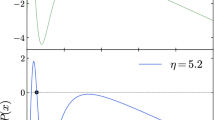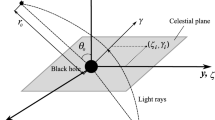Abstract
We study the strong gravitational lensing on the equatorial plane of a quasi-Kerr compact object with arbitrary quadrupole moments which can be used to model the super-massive central object of the galaxy. We find that, when the quadrupolar correction parameter ξ takes the positive (negative) value, the photon-sphere radius r ps, the minimum impact parameter u ps, the coefficient \( \overline b \), the relative magnitudes r m and the angular position of the relativistic images θ ∞ are larger (smaller) than the results obtained in the Kerr black hole, but the coefficient \( \overline a \), the deflection angle α(θ) and the angular separation s are smaller (larger) than that in the Kerr black hole. These features may offer a way to probe special properties for some rotating compact objects by the astronomical instruments in the future.
Similar content being viewed by others
References
W. Israel, Event horizons in static vacuum space-times, Phys. Rev. 164 (1967) 1776 [INSPIRE].
W. Israel, Event horizons in static electrovac space-times, Commun. Math. Phys. 8 (1968) 245.
B. Carter, Axisymmetric black hole has only two degrees of freedom, Phys. Rev. Lett. 26 (1971) 331 [INSPIRE].
S. Hawking, Black holes in general relativity, Commun. Math. Phys. 25 (1972) 152 [INSPIRE].
D. Robinson, Uniqueness of the Kerr black hole, Phys. Rev. Lett. 34 (1975) 905 [INSPIRE].
F. Caravelli and L. Modesto, Spinning loop black holes, Class. Quant. Grav. 27 (2010) 245022 [arXiv:1006.0232] [INSPIRE].
T. Johannsen and D. Psaltis, A metric for rapidly spinning black holes suitable for strong-field tests of the no-hair theorem, Phys. Rev. D 83 (2011) 124015 [arXiv:1105.3191] [INSPIRE].
C. Bambi and L. Modesto, Can an astrophysical black hole have a topologically non-trivial event horizon?, Phys. Lett. B 706 (2011) 13 [arXiv:1107.4337] [INSPIRE].
D. Psaltis, D. Perrodin, K.R. Dienes and I. Mocioiu, Kerr black holes are not unique to general relativity, Phys. Rev. Lett. 100 (2008) 091101 [arXiv:0710.4564] [INSPIRE].
F. Ryan, Gravitational waves from the inspiral of a compact object into a massive, axisymmetric body with arbitrary multipole moments, Phys. Rev. D 52 (1995) 5707 [INSPIRE].
L. Barack and C. Cutler, LISA capture sources: approximate waveforms, signal-to-noise ratios and parameter estimation accuracy, Phys. Rev. D 69 (2004) 082005 [gr-qc/0310125] [INSPIRE].
J. Brink, Spacetime encodings I — A spacetime reconstruction problem, Phys. Rev. D 78 (2008) 102001 [arXiv:0807.1178] [INSPIRE].
C. Li and G. Lovelace, A Generalization of Ryan’s theorem: probing tidal coupling with gravitational waves from nearly circular, nearly equatorial, extreme-mass-ratio inspirals, Phys. Rev. D 77 (2008) 064022 [gr-qc/0702146] [INSPIRE].
T.A. Apostolatos, G. Lukes-Gerakopoulos and G. Contopoulos, How to observe a non-kerr spacetime using gravitational waves, Phys. Rev. Lett. 103 (2009) 111101 [arXiv:0906.0093] [INSPIRE].
N.A. Collins and S.A. Hughes, Towards a formalism for mapping the space-times of massive compact objects: bumpy black holes and their orbits, Phys. Rev. D 69 (2004) 124022 [gr-qc/0402063] [INSPIRE].
S.J. Vigeland and S.A. Hughes, Spacetime and orbits of bumpy black holes, Phys. Rev. D 81 (2010) 024030 [arXiv:0911.1756] [INSPIRE].
J.R. Gair, C. Li and I. Mandel, Observable properties of orbits in exact bumpy spacetimes, Phys. Rev. D 77 (2008) 024035 [arXiv:0708.0628] [INSPIRE].
T. Johannsen and D. Psaltis, Testing the no-hair theorem with observations of black holes in the electromagnetic spectrum, Adv. Space Res. 47 (2011) 528.
C. Bambi and E. Barausse, Constraining the quadrupole moment of stellar-mass black-hole candidates with the continuum fitting method, Astrophys. J. 731 (2011) 121 [arXiv:1012.2007] [INSPIRE].
R.P. Geroch, Multipole moments. II. Curved space, J. Math. Phys. 11 (1970) 2580 [INSPIRE].
R. Hansen, Multipole moments of stationary space-times, J. Math. Phys. 15 (1974) 46 [INSPIRE].
G. Fodor, C. Hoenselaers and Z. Perjés, Multipole moments of axisymmetric systems in relativity, J. Math. Phys. 30 (1989) 2252.
S. Vigeland, N. Yunes and L. Stein, Bumpy black holes in alternate theories of gravity, Phys. Rev. D 83 (2011) 104027 [arXiv:1102.3706] [INSPIRE].
V.S. Manko and I.D. Novikov, Generalizations of the Kerr and Kerr-Newman metrics possessing an arbitrary set of mass-multipole moments, Class. Quantum Grav. 9 (1992) 2477.
K. Glampedakis and S. Babak, Mapping spacetimes with LISA: inspiral of a test-body in a ‘quasi-Kerr’ field, Class. Quant. Grav. 23 (2006) 4167 [gr-qc/0510057] [INSPIRE].
T. Johannsen and D. Psaltis, Testing the no-hair theorem with observations in the electromagnetic spectrum: I. Properties of a quasi-Kerr spacetime, Astrophys. J. 716 (2010) 187 [arXiv:1003.3415] [INSPIRE].
T. Johannsen and D. Psaltis, Testing the no-hair theorem with observations in the electromagnetic spectrum: II. Black-hole images, Astrophys. J. 718 (2010) 446 [arXiv:1005.1931] [INSPIRE].
T. Johannsen and D. Psaltis, Testing the no-hair theorem with observations in the electromagnetic spectrum. III. Quasi-periodic variability, Astrophys. J. 726 (2011) 11 [arXiv:1010.1000] [INSPIRE].
K. Virbhadra, D. Narasimha and S. Chitre, Role of the scalar field in gravitational lensing, Astron. Astrophys. 337 (1998) 1 [astro-ph/9801174] [INSPIRE].
K. Virbhadra and G.F. Ellis, Schwarzschild black hole lensing, Phys. Rev. D 62 (2000) 084003 [astro-ph/9904193] [INSPIRE].
C.-M. Claudel, K. Virbhadra and G. Ellis, The geometry of photon surfaces, J. Math. Phys. 42 (2001) 818 [gr-qc/0005050] [INSPIRE].
K.S. Virbhadra and G.F.R. Ellis, Gravitational lensing by naked singularities, Phys. Rev. D 65 (2002) 103004 [INSPIRE].
V. Bozza, Gravitational lensing in the strong field limit, Phys. Rev. D 66 (2002) 103001 [gr-qc/0208075] [INSPIRE].
V. Bozza, Quasiequatorial gravitational lensing by spinning black holes in the strong field limit, Phys. Rev. D 67 (2003) 103006 [gr-qc/0210109] [INSPIRE].
V. Bozza, F. De Luca, G. Scarpetta and M. Sereno, Analytic kerr black hole lensing for equatorial observers in the strong deflection limit, Phys. Rev. D 72 (2005) 083003 [gr-qc/0507137] [INSPIRE].
V. Bozza, F. De Luca and G. Scarpetta, Kerr black hole lensing for generic observers in the strong deflection limit, Phys. Rev. D 74 (2006) 063001 [gr-qc/0604093] [INSPIRE].
G.N. Gyulchev and S.S. Yazadjiev, Kerr-Sen dilaton-axion black hole lensing in the strong deflection limit, Phys. Rev. D 75 (2007) 023006 [gr-qc/0611110] [INSPIRE].
G.N. Gyulchev and S.S. Yazadjiev, Gravitational lensing by rotating naked singularities, Phys. Rev. D 78 (2008) 083004 [arXiv:0806.3289] [INSPIRE].
S. Frittelli, T.P. Kling and E.T. Newman, Space-time perspective of Schwarzschild lensing, Phys. Rev. D 61 (2000) 064021 [gr-qc/0001037] [INSPIRE].
V. Bozza, S. Capozziello, G. Iovane and G. Scarpetta, Strong field limit of black hole gravitational lensing, Gen. Rel. Grav. 33 (2001) 1535 [gr-qc/0102068] [INSPIRE].
E.F. Eiroa, G.E. Romero and D.F. Torres, Reissner-Nordstrom black hole lensing, Phys. Rev. D 66 (2002) 024010 [gr-qc/0203049] [INSPIRE].
E.F. Eiroa, A braneworld black hole gravitational lens: strong field limit analysis, Phys. Rev. D 71 (2005) 083010 [gr-qc/0410128] [INSPIRE].
E.F. Eiroa, Gravitational lensing by Einstein-Born-Infeld black holes, Phys. Rev. D 73 (2006) 043002 [gr-qc/0511065] [INSPIRE].
R. Whisker, Strong gravitational lensing by braneworld black holes, Phys. Rev. D 71 (2005) 064004 [astro-ph/0411786] [INSPIRE].
A. Bhadra, Gravitational lensing by a charged black hole of string theory, Phys. Rev. D 67 (2003) 103009 [gr-qc/0306016] [INSPIRE].
S.-b. Chen and J.-l. Jing, Strong field gravitational lensing in the deformed Hořava-Lifshitz black hole, Phys. Rev. D 80 (2009) 024036 [arXiv:0905.2055] [INSPIRE].
Y. Liu, S. Chen and J. Jing, Strong gravitational lensing in a squashed Kaluza-Klein black hole spacetime, Phys. Rev. D 81 (2010) 124017 [arXiv:1003.1429] [INSPIRE].
S. Chen, Y. Liu and J. Jing, Strong gravitational lensing in a squashed Kaluza-Klein Godel black hole, Phys. Rev. D 83 (2011) 124019 [arXiv:1102.0086] [INSPIRE].
T. Ghosh and S. Sengupta, Strong gravitational lensing across dilaton Anti-de Sitter black hole, Phys. Rev. D 81 (2010) 044013 [arXiv:1001.5129] [INSPIRE].
A.N. Aliev and P. Talazan, Gravitational effects of rotating braneworld black holes, Phys. Rev. D 80 (2009) 044023 [arXiv:0906.1465] [INSPIRE].
S.-W. Wei and Y.-X. Liu, Equatorial and quasi-equatorial gravitational lensing by Kerr black hole pierced by a cosmic string, Phys. Rev. D 85 (2012) 064044 [arXiv:1107.3023] [INSPIRE].
C. Darwin, The gravity field of a particle, Proc. Roy. Soc. London 249 (1959) 180.
J.B. Hartle, Slowly rotating relativistic stars. I. Equations of structure, Astroph. J. 150 (1967) 1005.
J.B. Hartle and K.S. Thorne, Slowly rotating relativistic stars. II. Models for neutron stars and supermassive stars, Astroph. J. 153 (1968) 807.
A. Einstein, Lens-like action of a star by the deviation of light in the gravitational field, Science 84 (1936) 506 [INSPIRE].
R. Genzel, F. Eisenhauer and S. Gillessen, The galactic center massive black hole and nuclear star cluster, Rev. Mod. Phys. 82 (2010) 3121 [arXiv:1006.0064] [INSPIRE].
V. Bozza and L. Mancini, Observing gravitational lensing effects by Sgr A * with GRAVITY, Astrophys. J. 753 (2012) 56 [arXiv:1204.2103] [INSPIRE].
Author information
Authors and Affiliations
Corresponding author
Rights and permissions
About this article
Cite this article
Liu, C., Chen, S. & Jing, J. Strong gravitational lensing of quasi-Kerr compact object with arbitrary quadrupole moments. J. High Energ. Phys. 2012, 97 (2012). https://doi.org/10.1007/JHEP08(2012)097
Received:
Accepted:
Published:
DOI: https://doi.org/10.1007/JHEP08(2012)097




